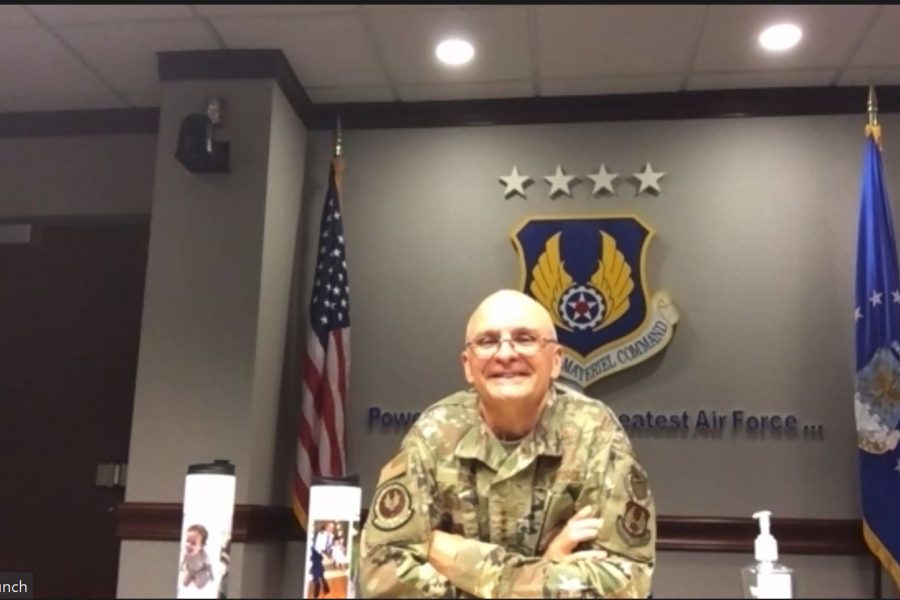A large fleet of B-21 bombers will alleviate a lot of the sustainment problems experienced with the B-2, but it’s not clear yet how the sustainment enterprise would have to change to adapt to mini-fleets of fighters developed under the Digital Century Series, Air Force Materiel Command chief Gen. Arnold W. Bunch Jr. said July 1.
Speaking on a Mitchell Institute “Aerospace Nation” streaming program, Bunch said the micro-size B-2 fleet of just 20 aircraft “causes supply and demand issues within the vendor base.” Producing “20 or 40 of something …is a whole different calculus” than contracting for thousands of parts at a time.
“We have to learn those lessons” for the B-21, he said, adding it’s important the fleet size be large enough. Gen. Timothy M. Ray, head of Air Force Global Strike Command, has “done a very good job explaining … why we have to have a larger force” of stealth bombers, and the “critical need” for them, Bunch said. Ray has suggested a B-21 force of well over 100 aircraft, and an overall bomber fleet of more than 220 aircraft.
Having a large fleet make it “more lucrative” for industry to invest in supporting it, so “it’s critical we keep the numbers up,” Bunch said. The Air Force has set up the B-21 to have an open mission systems architecture so it can regularly and competitively have its technology refreshed, he noted.
“For those small fleets, it is really hard to get a vendor base to be willing to make those kinds of investments and sustain that capability for the longer period of time,” he said, and it’s an issue “we’re really going to have to watch.”
Bunch acknowledged that Air Force acquisition executive Will Roper is pursuing small fleets with his Digital Century Series model, which aims to build up to 100 aircraft of a given type but not keep them more than a decade, introducing new airplanes at the speed of relevance and eliminating the need to sustain fleets for decades.
“It will be different,” Bunch said of the new model, and it will force “a mindset change.”
Roper is leading the business case analysis and the “communication with industry,” Congress, and the Office of the Secretary of Defense to explain the benefits of the new model, Bunch said. He will have to “get industry to understand … what you’re incentivizing is the development, and not the long-term production … and sustainment.” Roper will make the case that “we’re moving out, … and why it’s so important to do … to stay relevant,” Bunch said.
The new model will have to be focused on new systems, though. Bunch said he doesn’t see it radically changing how USAF depots operate because the the service will be retaining systems like the B-52, KC-135, and new aircraft like the KC-46 and B-21 for many years to come. “We don’t know the full impact” yet, he said. “We’ll have to see how it progresses.”
Also during the event, Bunch was asked what lessons the Air Force learned from its attempts to comply with former Defense Secretary James N. Mattis’ directive to achieve mission capable rates of 80 percent on the F-22, F-35, and F-16.
“The clear lesson was, if we put money in, we’re going to generate aircraft,” he said. The Air Force made a big effort to fill parts bins and, particularly with the F-16, that led to “big jumps” in readiness “that we hadn’t seen” before.
On the F-22, “we did the same thing. That took more time, but we’re seeing the benefits of that now,” he noted. Many parts were from “small vendors where we didn’t have quite the demand signal on the industrial base,” and those vendors “were not producing parts at the level we would need …because of the demand signal with the smaller fleet.” But MC rates went up, and “if we put the money into it, industry is going to respond.”
A cautionary note, though, was that USAF focused on combat units, and less on training units, and that had “second and third-order effects.” It’s something “We have to think our way through.”
Bunch said the 80-percent MC rate goal has been superseded by a focus on meeting regional commanders’ needs. “I have a regular meeting with the other Majcom commanders on an aircraft availability improvement program,” he said. “That is our focus: what does the Majcom commander who owns those platforms need to be able to do his training, his readiness, all aspects of his mission set,” and where do AFMC, its Program Executive Officers, and Roper “need to be making investments … Is it a component that is failing too often? Is it in increasing sustainment or engineering…?”
AFMC is focusing on “what are the drivers for aircraft availability; what causes the numbers to go the wrong way; and where is the wisest investment that we can make. That is what our focus is right now: What can we do with the dollars available to increase aircraft availability,” Bunch said.
Asked what the new benchmark of “ready” is, he said there are “three things we look at: What are we actually getting? What is planned? And that is what we are actually funded to … the standard,” which is “what the Majcom commander believes that he needs to be able to do everything” required of him.
“As you can probably imagine, we’re not funded at the ‘standard’ rate; usually at the ‘planned’ rate,” Bunch explained. The “contract” between AFMC and Majcom leaders “is to make sure we meet those needs as best we can. There are some tradeoffs we have to do there. I do not have enough invested in a lot of the channels to be able to be at the standard, but we do measure ourselves against what the ‘plan’ is for the year.”
